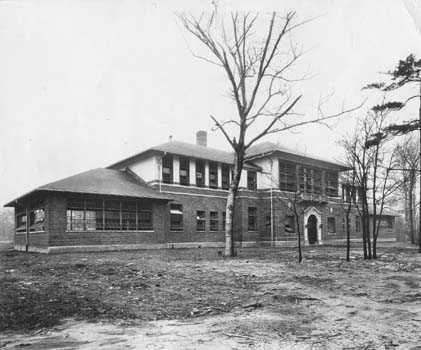Fresh Air Education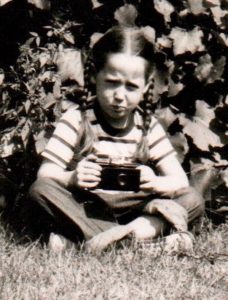
I was six-years-old in 1950 when a doctor thought it could be good for me to attend a special Indianapolis school for kids who had trouble staying healthy. I wasn’t sure I wanted to go there, but I was a kid who tried her best to please, so if I could figure out what was needed to get admitted, I’d do it.
To be chosen for the Theodore Potter Fresh Air School I had to be chronically sick, but not contagious, or underweight, but with the potential to gain. Regardless, I could not be mentally disabled although being a nervous wreck was just fine.
The Potter School was an adaptation of the Open Air or Fresh Air schools that began after the turn of the century. With expansive open windows, they were thought to be an enlightened way to toughen up frail children and prevent tuberculosis.
The early school uniforms were stitched of 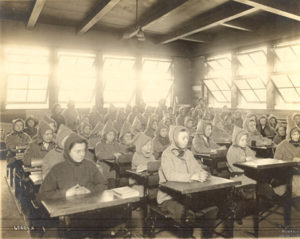 heavy blankets that looked like hooded monks’ cloaks to be worn over street clothes on cold days. Happily, by the time I was recommended, the purist version of those schools had been modified with more heat and no cloaks.
heavy blankets that looked like hooded monks’ cloaks to be worn over street clothes on cold days. Happily, by the time I was recommended, the purist version of those schools had been modified with more heat and no cloaks.
The Fresh Air School movement was the ultimate in outcome-based education. If its students gained weight or missed fewer days of class, the school was a success.
My Health
I’d had multiple bouts of pneumonia, so I’d missed many days of kindergarten and first grade. My physician, Dr. Snyder, lived through the back alley and he occasionally stopped by to check on me after work. He was a slight man with horned-rimmed glasses whose soft words oozed out from under a dark pencil mustache. The aroma of pipe tobacco always floated in as he arrived to check on my lungs.
As he warmed the stethoscope in his hands, he discovered that I could gulp air and keep chugging words whenever someone came into my room. He often reminded me with a smile, “Hey now, I came to listen to your lungs.”
Sometimes I went to Methodist hospital for x-rays and to see specialists. One of them recommended the Potter School and gave Mother information about an upcoming examination to see if the place would be a good fit for me.
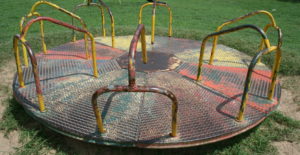
Social merry-go-round
During kindergarten and first grade, when I made it to school after an illness, I didn’t have a clear role in the social whirl of class. My outlier status was most evident on the playground. Schoolyards of that era had equipment that could bring serious merriment or mayhem, and when things went right, I loved it all.
The equipment that caused me the most joy was the metal merry-go-round. I would run in the dust or mud to push and give riders a spin before I tried to jump on. But often, when I pulled myself up, everyone else ran off to something else.
My status as a fringe player was most evident when I tried to get a thrill on the seesaw.
Seesaws of that era were serious business. It was best to have a partner who was about the same weight so that a little shift in position could get it all in perfect harmony to send one rider up and the other down. 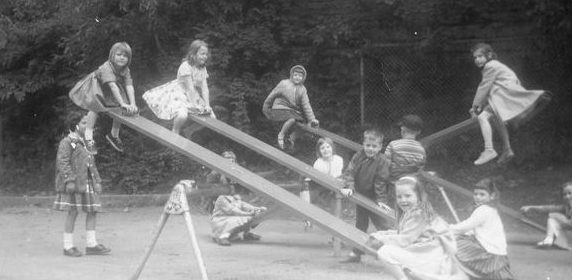
Parents of today could take one look at this picture and see the potential for a lot to go wrong. Just like in the photo, sometimes boys would try to mess with the equilibrium by pressing down one side and then letting go quickly for a sudden change in direction. This release resulted in a jarring jolt to the ground or a thrilling bump in the air. This caused a girl in my class to break an arm, but the parents only complained about the lack of supervision on the schoolyard.
Potential disasters aside, I loved riding on the seesaw, but I could seldom get anyone to ride with me. So while excitement like a dodgeball game went on elsewhere, I’d get on a seesaw and crawl to the middle where I carefully covered my rump with my skirt and then rocked on my knees for a little thrill.
It seems it didn’t take much to make me happy.
My Tryout
We went to my examination at the Potter School on a warm July morning. As a little kid, I tried hard to please, so I was nervous about how to act. My mother had me spiffed up with tight braids and sabbath clothes to look proper. She toted a bundle of x-rays and medical records which she consulted as she filled out forms.
Occasionally as she wrote down answers, she would pause and ask me a question with an obvious answer such as, “How often does your child wet the bed?” Since that was not one of my problems, we enjoyed a little chuckle in the midst of the seriousness.
As other hopeful children and parents gathered in the school cafeteria, I looked around at potential candidates and thought that I might not be sick enough for the Potter School. I was small for my age, but I wasn’t crooked or bent over, my head was normal sized, and I didn’t use a wheelchair or crutches.
My conclusion about my comparative well-being might have made me grateful. But it didn’t. I only worried about how I would be able to make the cut.
Screen dividers were set up for the examinations. When I finally went behind them, the doctor smelled like pipe smoke just like Dr. Snyder. Since our family practiced a religion that taught tobacco was an unhealthful sin, I thought it was a strange coincidence for a couple of doctors.
The doctor sounded clinical as he looked at x-rays and asked Mom questions while he dictated his observations to a nurse. He concluded that I would benefit from the school, but that there may be students who needed it more than I did.
We left expecting a call in a few days.
As I rode home, I realized that my behavior or look on my face did not matter. I couldn’t have screwed up my tryout based on the information the doctor was interested in knowing.
While Mom drove, the winds of a muggy July day blew my worries away.
Accepted!
When Mother got the call about my admittance to the Potter School, she used words like “wonderful” and “special” as she told me I was going to class by taxi each day. I was just happy that someone thought I belonged someplace.
Later that night, I as I lay in bed thinking about my new unknown, I realized that we hadn’t seen the playground, and I wondered if my new school had a seesaw.
Photo of merry-go-round from Calsidyrose on Flickr. Photo of seesaw from the History Center in Tompkins County. Photos of the Theodore Potter School are used with permission of the Indiana State Library.
